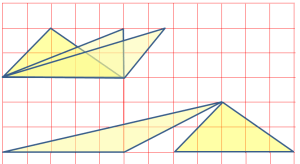According to Piaget, knowledge is constructed when a learner encounters input from the environment and incorporates the new experiences to his/her existing schemes and mental structures (assimilation). When this new assimilated information conflicts with previously formed mental structures, the result is called disequilibrium – a cognitive conflict. This state of disequilibrium motivates the learner to seek equilibrium. The cognitive conflict approach to teaching is based on this assumption – that learners will seek this equilibrium.
Cognitive conflict approach to teaching exposes students in situations where some of their existing understandings about an idea or a topic no longer hold. A famous example on this is the Chords and Regions activity:
Find a way of predicting the maximum number of regions created by chords connecting n points.
This activity is usually used to challenge students thinking that patterns observed will always hold true and that patterns can be used as proof. The pattern observed will not hold true for n > 5. You can read the result of this activity in this paper Chords and Regions.
The assumption that learners will seek equilibrium when they are put in a situation of disequilibrium, when they experience cogntive conflict isn’t often the case. In fact, a common challenge faced by the cognitive conflict approach is that students often possess ‘contradictory understandings’ (from a mathematical point of view) but they don’t feel the need to address the inconsistencies in their understandings. This is the reason why it is very hard to correct a misconception. Also, students often do not see the importance (or necessity) to engage in a process of modifying their understandings to resolve the contradictions and they tend to treat the contradictions as exceptions (Stylianides & Stylianides, ICME-11). In the above activity for example, instead of being challenged, students can just accept the fact that the pattern stops after n=5 and not try to think of a more general rule to cover all cases. It is also possible that students can just say Next time I’ll try up to 10 cases before generalizing. This is now the challenge to the teacher. As a teaching approach, the use of cognitive conflict has a lot of potential but it needs more than simply using the appropriate task to create the conflict. Our students can be very resilient.
Mary Pardoe via LinkedIn discussion suggests that a strategy that encourages students to confront, rather than avoid, a cognitive conflict is to challenge small groups of students to reach a group conclusion (about the situation) with which everyone in the group agrees. Students who individually might respond differently to the ‘conflict’ will usually then try to persuade each other that their own points of view are correct, and so they are motivated to explain and discuss their thinking. Sample teaching using this approach is described in Using cognitive conflict to teach solving inequalities.
Common misconceptions are also rich sources of tasks for creating cognitive conflict. Click the link Mistakes and Misconceptions and Top 10 Errors in Algebra for sample of tasks.
You may want to check the book below to get more ideas on teaching mathematics.









